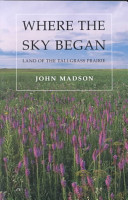Native Inclinations

As an extension of my landshaping work in Iowa, I currently serve on a committee formed not long ago by the Johnson County Heritage Trust. Our mission is simple but immense: to preserve as much of the natural environment as possible.
The committee was formed in response to development of a new subdivision in a high-quality oak/hickory forest in which relatively few invasive species had gained footholds. Our immediate task was to compile a list of acceptable plants for this community as well a list for the whole county.
Of course, this story is much larger than my home county: Throughout the United States, builders are developing more and more communities in native regions or on land abutting wilderness areas. In many cases, happily, landscape architects and designers have been given the opportunity to create environmentally responsible designs for these sites.
For me, one of the most important points to consider in this larger, overall effort is plant selection.
The native landscape has been a great interest of mine ever since I read John Madson’s Where the Sky Began (Sierra Books, 1985), which beautifully depicts the pioneers’ crossing of the Mississippi into the Plains states. It sensitized me to issues of local conservation, and I’ve wrestled with its potent implications on a regular basis ever since.
Which plants should never be used? Are there locations where some plants are acceptable and others where the same plants are not? Should I have a list for acreages and another for town-center lots? Are non-invasive exotics acceptable? Should I avoid cultivars or varieties? I’m sure most of you have grappled with these same issues often enough to know that solutions vary for every state, community, property and design.
Indeed, meeting new clients and visiting different sites every week means a different set of criteria for design and plant selection. And the fact is that I sometimes don’t have time for detailed, personal research and need to rely in part on information from colleagues or other specialists in the field.
My most immediate need is often knowledge about which plants are invasive and which are not, whether native or non-native. And then I need to know which of the acceptable plants are available – and if they’re not, figure out a way to make growers aware of the value of and need for these plants.
The Internet is proving an invaluable resource in this arena, and the sidebar below carries a list of some of the best web sites I’ve found from around the country. If you don’t see a web site that pertains to your locality, try searching with the headings “native plants” and “invasive plants” along with your state’s name: It’s certain to yield a lengthy list of resources.
|
On the Web http://plants.usda.gov has lists of invasive and noxious weeds in the United States and by state. There is also a link to help you choose plants for conservation purposes. — J.N. |
Judy Nauseef has owned and run Judy Nauseef Landscape Design in Iowa City, Iowa, for the past 16 years, providing landscape design and consultation services as well as installation management for her clients. An active, certified member of the Association of Professional Landscape Designers, she is widely published and is a frequent speaker for garden clubs. She may be reached at [email protected].










